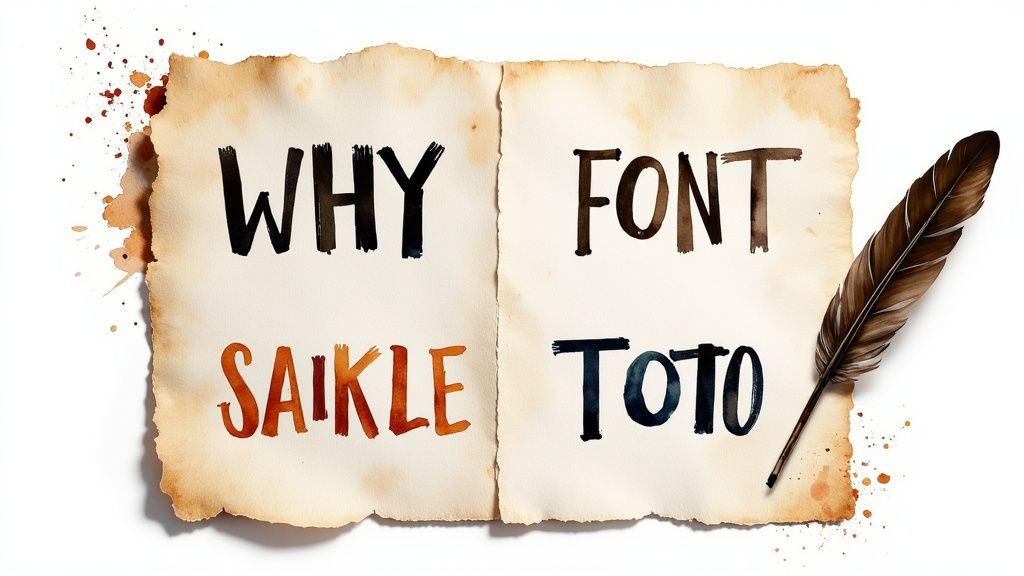The Real Impact of Editorial Style Guides

Editorial style guides serve as the foundation for creating consistent, high-quality content that truly resonates with audiences. When properly implemented, these guides help content teams work more efficiently while maintaining brand standards. Companies that use well-developed style guides typically see faster content reviews, fewer revision rounds, and better brand alignment across all their communications channels.
Streamlining Content Creation and Review
A clear style guide acts like a roadmap for content teams, making the entire creation process smoother and more efficient. Just as architects need blueprints before construction begins, writers and editors need defined standards for grammar, tone, and formatting. This clarity eliminates confusion and reduces back-and-forth discussions about style choices. For example, when everyone knows the preferred approach for elements like headlines or product names, they can focus on crafting compelling content rather than debating format details. Teams working in fast-paced environments especially benefit from this efficiency, as it helps them maintain quality even under tight deadlines.
Ensuring Brand Consistency Across Channels
Building trust with your audience requires a consistent voice whether someone encounters your brand on your website, social media, or marketing materials. Style guides help achieve this by providing specific direction on language, tone, and formatting across all platforms. For instance, your guide might outline how to adapt your brand voice for different channels while keeping core elements consistent. This unified approach helps audiences instantly recognize and connect with your content, regardless of where they find it.
Empowering Content Creators
Good style guides give content creators the tools and confidence to produce their best work. Instead of getting stuck on basic style decisions like whether to spell out numbers or use the Oxford comma, writers can reference clear guidelines and move forward with creating engaging content. This freedom allows them to focus on storytelling and connecting with readers. When content teams understand the "why" behind style choices, they become more invested in maintaining brand standards and often develop creative ways to express the brand voice while staying within guidelines. You might be interested in: Understanding the Importance of Quality Content: A Strategic Guide for Modern Marketers.
Measuring Style Guide Effectiveness
To ensure your style guide remains valuable, it's essential to track its impact on your content process. Pay attention to metrics like the number of revision rounds needed, time spent in review, and overall content performance. This data reveals where the guide works well and where it might need updates. For example, if certain types of content consistently require multiple revisions, that section of the guide may need clarification. Regular monitoring and updates keep your style guide relevant and effective, helping your content strategy align with business goals.
Inside NASA's Technical Writing Playbook

When it comes to technical documentation, few organizations match NASA's standards for clarity and precision. Their editorial style guide serves as a gold standard for communicating complex information effectively. Let's explore the key elements that make NASA's approach so successful and see how these principles can improve any technical writing project.
Numerical Formatting for Precision
Numbers matter immensely in technical writing, which is why NASA has developed specific rules for formatting them. The guide requires commas in numbers with four or more digits (like 32,000 or 1,000,000) to make them instantly readable. This simple but crucial rule helps prevent costly misinterpretations of critical data. There are some practical exceptions - years (1969, 2024) and page numbers don't use commas. By following these consistent formatting rules, NASA ensures that numerical information is crystal clear across all their documentation.
Navigating Technical Terminology
Clear communication depends on everyone speaking the same language, especially with technical terms. NASA's guide includes a detailed glossary that defines aerospace terminology precisely. For example, it carefully distinguishes between related terms like "apogee" (the farthest point from Earth in an orbit) and "perigee" (the closest point). By maintaining this shared vocabulary, teams can communicate efficiently and avoid misunderstandings that could impact mission success.
Structuring Documents for Clarity
Beyond individual words and numbers, NASA's guide provides clear blueprints for organizing entire documents. Each type of document - whether it's a technical report, proposal, or manual - follows specific formatting requirements. The guide also includes practical details like using numbered footnotes that restart with each chapter. This careful attention to document structure helps readers quickly find the information they need, even in lengthy technical materials.
Practical Applications Beyond Aerospace
While NASA created these guidelines for space exploration, their principles work equally well in other technical fields. Consider medical documentation, where precise language can affect patient care. Or think about software development, where clear documentation helps teams build and maintain complex systems. By adopting NASA's emphasis on consistent terminology, clear numerical formatting, and logical document structure, any organization can make their technical writing more effective. These improvements lead to better teamwork, fewer errors, and more successful projects across all industries.
Urban Institute's Blueprint for Inclusive Content
Building on NASA's precise approach to technical writing, the Urban Institute offers another excellent editorial style guide that puts inclusivity front and center. Their guide shows how organizations can effectively reach diverse audiences while keeping their message clear and impactful. This goes beyond simple etiquette - it's about building genuine connections and ensuring your content resonates with everyone who encounters it.
Respectful Language as a Foundation
At its core, the Urban Institute's guide emphasizes choosing words that honor different life experiences and perspectives. Rather than just avoiding offensive terms, it encourages writers to actively select language that brings people together. For instance, instead of using loaded phrases like "inner-city youth," the guide suggests more neutral descriptions like "young people living in urban areas." These small but meaningful shifts in language can dramatically affect how readers connect with your content.
Practical Guidance on Sensitive Topics
Writing about complex social issues presents unique challenges. The Urban Institute tackles this head-on by providing clear frameworks and specific word choices for discussing sensitive subjects. Their recommendations help writers address important topics thoughtfully, opening doors for meaningful dialogue rather than putting up walls. The guide offers concrete examples for discussing race, ethnicity, gender, and socioeconomic status, giving content creators the tools to handle difficult conversations with care and confidence.
Terminology and Style Choices That Matter
The guide dives deep into specific language choices that shape inclusive content. It covers everything from referring to age groups appropriately to avoiding stereotypes in descriptions. These details show how creating inclusive content requires attention at every level of writing. For example, rather than using vague terms like "elderly," the guide recommends precise language such as "older adults" or "people over 65." This level of consideration helps create content that truly reflects and respects your audience's diversity.
Creating Your Own Inclusive Style Guide
Looking to develop your own inclusive content guidelines? The Urban Institute's guide offers an excellent starting point. By focusing on respectful language, clear guidelines for sensitive topics, and specific terminology recommendations, you can build a strong foundation for inclusive communication. Start by examining your organization's values, looking for potential bias in your current content, and creating clear guidelines that help your team write with respect and purpose. This commitment to inclusivity not only strengthens your brand but creates a more welcoming space for everyone in your audience.
Academic Excellence: UW Oshkosh's Writing Framework

While the Urban Institute focuses on inclusive writing, the University of Wisconsin Oshkosh History Department takes a different approach with their editorial style guide. Their framework shows students how to turn basic historical research into compelling academic arguments. Though designed for history majors, their methods offer valuable lessons for anyone doing scholarly research and writing.
Crafting Persuasive Arguments in History
The UW Oshkosh guide emphasizes that history papers should do more than just list facts - they need to make persuasive arguments. Students learn to think like lawyers building a case, carefully selecting and presenting evidence to support their interpretation of historical events. For example, rather than simply describing what happened during World War II, a student might argue how specific economic factors influenced key military decisions. This approach helps writers engage more deeply with their research material.
The Power of the Thesis Statement
A clear thesis statement forms the foundation of any strong academic paper at UW Oshkosh. This single sentence, usually at the end of the introduction, must capture the paper's main argument. For instance, instead of broadly stating "The Great Depression affected many Americans," an effective thesis might argue "The Great Depression fundamentally reshaped American attitudes toward government assistance programs." This focused approach gives both writers and readers a clear roadmap through the analysis that follows.
Integrating Research Effectively
The guide provides concrete steps for weaving research seamlessly into historical writing. Students learn to analyze primary and secondary sources critically, taking detailed notes on different perspectives and evaluating source credibility. Rather than just dropping in quotes, writers must show how each piece of evidence supports their larger argument. The guide also requires precise citations for every claim, using footnotes that restart with each chapter - similar to NASA's emphasis on documentation precision. This careful approach lets readers trace arguments back to their source materials.
Finding Your Academic Voice
Beyond technical requirements, UW Oshkosh encourages students to develop their own scholarly voice. While maintaining academic standards, writers can express their unique perspectives on historical events. The guide shows how to balance formal writing conventions with engaging storytelling that draws readers in. For example, a paper about the Civil War might open with a vivid scene that illustrates the broader themes to come. By focusing on clear, accessible language and avoiding unnecessary jargon, writers can produce work that appeals to both academic and general audiences while meeting rigorous scholarly standards.
Harvey Mudd's Guide to Style Guide Integration

Creating a strong brand voice requires a smart approach to style guidelines, and Harvey Mudd College shows how to do this effectively. Their method proves that combining multiple style guides isn't about cramming rules together - it's about carefully selecting what works best from each source. This allows them to adapt their writing for different situations while keeping their overall brand message clear and consistent.
Combining AP and Chicago Styles
Harvey Mudd bases most of their writing on the Associated Press Stylebook and Webster's Collegiate Dictionary for clear, accessible communication. But they know some content needs a different touch. For academic citations and detailed formatting, they turn to The Chicago Manual of Style. This flexibility is like having the right tools for different jobs - you wouldn't use a screwdriver to hammer a nail, and Harvey Mudd picks the best style rules for each type of writing they do.
Addressing Institution-Specific Needs
While AP and Chicago style guides cover most writing situations, they don't address everything unique to a specific organization. Harvey Mudd solves this by including special guidelines for terms and phrases specific to their school. For instance, they clearly explain how to write about their academic programs and campus locations. These detailed instructions help everyone write consistently about Harvey Mudd-specific topics, making their message clearer for readers who might not know their terminology.
Practical Examples of Style Integration
You can see how well this combined approach works in Harvey Mudd's materials. Their website content follows AP style rules for clarity and readability, making it easy for prospective students and visitors to understand. Meanwhile, their academic publications use Chicago style's detailed citation rules, showing the scholarly nature of their work. This shows how using different style guides lets them match their writing to their audience and purpose.
Maintaining Consistency Across Platforms
One challenge when using multiple style guides is keeping everything consistent across different types of communication. Harvey Mudd handles this by creating one main style guide that everyone can reference. This helps avoid confusion whether someone is writing a press release, website content, or academic paper. You might be interested in: 10 Best Content Creation Tools: A Professional's Guide to Content Excellence. Having this central resource helps writers make good choices and keeps the school's voice consistent. By blending established writing rules with their own guidelines, Harvey Mudd shows other organizations how to create clear, consistent communication.
Building Your Style Guide Gameplan
A strong editorial style guide is the backbone of any organization's communication strategy. From small details like punctuation choices to big-picture elements like brand voice, every aspect contributes to clear and effective messaging. So how do you create a style guide that truly works for your team? Let's break down the key components and practical steps to build your own.
Essential Components of an Effective Style Guide
At its core, your style guide should establish clear standards that make content creation smoother and more consistent. Here are the fundamental elements to include:
- Voice and Tone: Set clear guidelines for how your brand speaks to its audience. Mailchimp does this exceptionally well with its friendly, approachable tone that stays consistent across all content.
- Grammar and Mechanics: Spell out your stance on common writing questions like Oxford commas, numbers, and abbreviations. The NASA History Style Guide offers a great example, with detailed rules for technical writing like using commas in numbers over four digits.
- Terminology: Create a clear glossary of brand-specific terms, product names, and industry jargon. Like Harvey Mudd College, consider supplementing standard style guides with your own specialized terms.
Formatting and Style Considerations
Good formatting makes content easier to read and understand. Your guide should address:
- Headings and Subheadings: Define a clear hierarchy with specific rules for capitalization and formatting at each level
- Lists and Bullets: Set standards for bullet style, spacing, and punctuation
- Visuals and Multimedia: Include guidelines for images, captions, and video placement to maintain visual consistency
Ensuring Adoption and Maintaining Relevance
The best style guide won't help if no one uses it. Make your guide successful by focusing on:
- Accessibility: Keep your guide in an easy-to-search digital format that the whole team can access
- Training and Support: Help your team learn and apply the guidelines through regular training sessions
- Regular Review and Updates: Language evolves, so update your guide regularly. The Urban Institute's guide shows how to adapt guidelines for changing social contexts. Learn more about creating effective content in our guide on How to create engaging content.
Measuring the Impact of Your Style Guide
Track these key metrics to gauge your style guide's effectiveness:
- Content Consistency: Check if terminology and formatting stay uniform across channels
- Review Time: Monitor if content reviews move faster with fewer style-related edits
- Content Performance: See if clearer, more consistent content leads to better engagement
By following these guidelines and learning from successful examples, you'll create a style guide that helps your team produce better content more efficiently. A well-crafted guide does more than enforce rules - it empowers your team to communicate with clarity and purpose.
Want to take your content creation to the next level? Try Aeon, an AI-powered video platform built for publishers. Turn your text, audio, and video content into engaging videos with ease. Visit Aeon today to see how we can help amplify your brand's message.